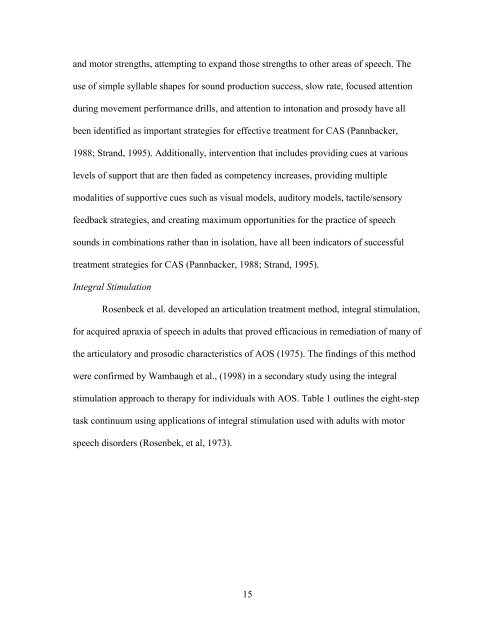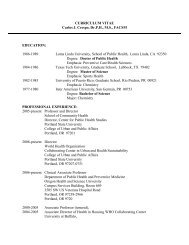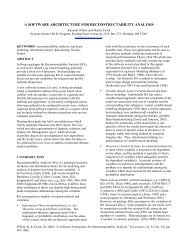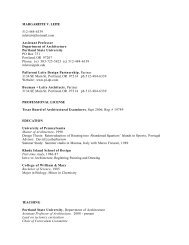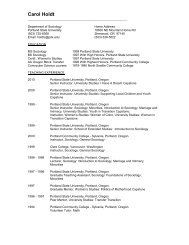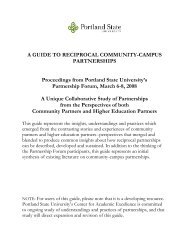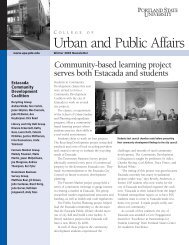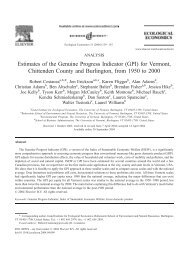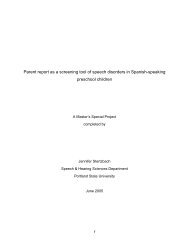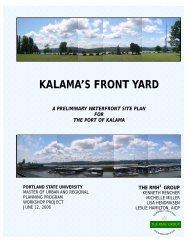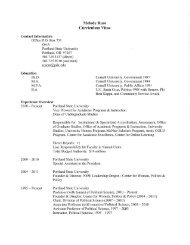Effects of integral stimulation therapy on speech - Portland State ...
Effects of integral stimulation therapy on speech - Portland State ...
Effects of integral stimulation therapy on speech - Portland State ...
Create successful ePaper yourself
Turn your PDF publications into a flip-book with our unique Google optimized e-Paper software.
and motor strengths, attempting to expand those strengths to other areas <str<strong>on</strong>g>of</str<strong>on</strong>g> <strong>speech</strong>. The<br />
use <str<strong>on</strong>g>of</str<strong>on</strong>g> simple syllable shapes for sound producti<strong>on</strong> success, slow rate, focused attenti<strong>on</strong><br />
during movement performance drills, and attenti<strong>on</strong> to int<strong>on</strong>ati<strong>on</strong> and prosody have all<br />
been identified as important strategies for effective treatment for CAS (Pannbacker,<br />
1988; Strand, 1995). Additi<strong>on</strong>ally, interventi<strong>on</strong> that includes providing cues at various<br />
levels <str<strong>on</strong>g>of</str<strong>on</strong>g> support that are then faded as competency increases, providing multiple<br />
modalities <str<strong>on</strong>g>of</str<strong>on</strong>g> supportive cues such as visual models, auditory models, tactile/sensory<br />
feedback strategies, and creating maximum opportunities for the practice <str<strong>on</strong>g>of</str<strong>on</strong>g> <strong>speech</strong><br />
sounds in combinati<strong>on</strong>s rather than in isolati<strong>on</strong>, have all been indicators <str<strong>on</strong>g>of</str<strong>on</strong>g> successful<br />
treatment strategies for CAS (Pannbacker, 1988; Strand, 1995).<br />
Integral Stimulati<strong>on</strong><br />
Rosenbeck et al. developed an articulati<strong>on</strong> treatment method, <str<strong>on</strong>g>integral</str<strong>on</strong>g> <str<strong>on</strong>g>stimulati<strong>on</strong></str<strong>on</strong>g>,<br />
for acquired apraxia <str<strong>on</strong>g>of</str<strong>on</strong>g> <strong>speech</strong> in adults that proved efficacious in remediati<strong>on</strong> <str<strong>on</strong>g>of</str<strong>on</strong>g> many <str<strong>on</strong>g>of</str<strong>on</strong>g><br />
the articulatory and prosodic characteristics <str<strong>on</strong>g>of</str<strong>on</strong>g> AOS (1975). The findings <str<strong>on</strong>g>of</str<strong>on</strong>g> this method<br />
were c<strong>on</strong>firmed by Wambaugh et al., (1998) in a sec<strong>on</strong>dary study using the <str<strong>on</strong>g>integral</str<strong>on</strong>g><br />
<str<strong>on</strong>g>stimulati<strong>on</strong></str<strong>on</strong>g> approach to <str<strong>on</strong>g>therapy</str<strong>on</strong>g> for individuals with AOS. Table 1 outlines the eight-step<br />
task c<strong>on</strong>tinuum using applicati<strong>on</strong>s <str<strong>on</strong>g>of</str<strong>on</strong>g> <str<strong>on</strong>g>integral</str<strong>on</strong>g> <str<strong>on</strong>g>stimulati<strong>on</strong></str<strong>on</strong>g> used with adults with motor<br />
<strong>speech</strong> disorders (Rosenbek, et al, 1973).<br />
15


